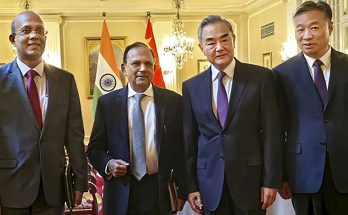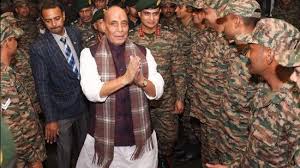The Indo-Pacific’s blurred geographical outreach with the larger Asia-Pacific region has overshadowed the former’s contribution to emerging trade facilitations and connectivity lines from and through the region. The emergence of the Indo-Pacific as a region which is distinct from the Asia-Pacific in terms of geostrategic significance, as opposed to it being a sub-region of the Asia-Pacific, is yet to happen. The cooperation between the US and India in this region has the potential to effect this much needed transformation. The due recognition of the Indo-Pacific as a credible maritime domain with its unique ability to provide access to both the Indian Ocean and the Asia-Pacific countries is likely to happen once India and the US will come together to cooperate through the waters of the Indo-Pacific, giving mutual access to each other in the Indian Ocean and the Asia-Pacific regions. The US-India Joint Strategic Vision for the Asia-Pacific and Indian Ocean Region is in the direction of further concretising this possibility by adding strategic overtones to an already emerging economic partnership between the two countries in the Indo-Pacific. Outlining a joint strategic vision for the Asia-Pacific and the Indian Ocean enhances the scope of cooperation for both, India in its capacity as an emerging maritime power that seeks to play the role of a net-security provider by recalibrating its Indian Ocean strategy, and the US as a resident power in the Asia-Pacific that promises to bolster its Rebalance to Asia policy.
Indo-Pacific strategy?
What has caught the eyes of observers watching this region closely is the omission of any specific strategy apropos the Indo-Pacific region in the joint document released during US President Barack Obama’s visit to India in January this year, as opposed to clear references to regions straddling the Indo-Pacific. The term Indo-Pacific, it needs to be noted, has been given a miss in the Indo-US Joint Strategic Vision; its conspicuous absence seems to suggest that the term has been avoided to highlight an obvious and tacit inclusion of the Indo-Pacific as a single strategic expanse connecting two important geostrategic maritime domains in Asia; the Indian Ocean and the Asia-Pacific.
Indo-US Maritime Cooperation: A ‘Joint Strategic Vision’
The second Obama visit to India earlier this year led to the addition of a very important dimension in the overall framework of Indo-US relations; one that seeks to increase maritime cooperation between the two countries. The visit resulted in a very important document; the Joint Strategic Vision for the Asia-Pacific and Indian Ocean Region, which affirms the shared vision for promising prosperity and stability in the region, besides assuring concrete understandings and partnerships in the area of defence relations. First, the document assumes great importance as it is the first standalone document that links mutual support between India and the US in both the Asia-Pacific region and the Indian Ocean. The obvious hint here is the importance of linking both these regions, both for India and the US. With clear reference to security and ensuring freedom of navigation and over flight throughout the region, especially in the South China Sea (SCS), the joint strategic vision suggests for the first time that India and the US could well come together, in future, to ensure a rule-based sea order. Cooperation in security forms an indispensible part in the Indian Ocean, the Indo-Pacific and the South-China Sea. Within the scope of the joint outlined vision, maritime security has been jointly highlighted as a key area of cooperation in the document.
Rebalancing Games: The China Factor
The other area where both India and the US can be expected to boost maritime cooperation in both the Asia-Pacific and the Indian Ocean is an increase in the frequency of naval exercises and engagements. In the document, both the countries have pledged more frequent naval engagements, such as the bilateral MALABAR exercise, to improve cooperation between the U.S. and Indian maritime forces and contribute to both sides’ ability to counter threats at sea, from piracy to violent extremism. These engagements also present opportunities to engage with other partners, particularly Japan, Vietnam and Australia. India’s growing closeness to these countries augurs well with these countries’ proximity to Washington and only complements the US’ ‘concert of democracies’ rhetoric which it emphasises, is needed to bring about a rule-based maritime order in Asian waters, mostly disquieted by Chinese activities in the South China Sea (SCS); most recently the land reclamation strategy adopted by China that has been opposed by the US.
However, what sets this document aside is a direct mention of South China Sea. It is clear that both the US and India converge in their interests when it comes to freedom of navigation in the South China Sea and both the countries are likely to protest against any move that China will make in violation of international maritime laws. To that extent, maritime cooperation between India and the US, enunciated through the joint statement, is more of a consensus against China in these regions, rather than a strategic counterpoint. However, both the countries share an unease over China and the convergence of India’s renewed ‘Act East’ and US’ Rebalance might well be a strategy in making against the growing Chinese influence in both the Asia-Pacific and the Indian Ocean.
US-India: Convergences in the Indo-Pacific
As the US intends to play a larger role in greater regional engagement and integration in the Indo-Pacific, it has laid out the criticality of India’s cooperation in this endeavour. Bridging the gap between South and Southeast Asia through the Indo-Pacific is an important project that both the US and India find common interests in. The US has a parallel envisioning with India’s refashioned Act East policy through the promotion of the Indo-Pacific Economic Corridor (IPEC) and its Rebalance strategy. India’s contiguity with states like Bangladesh and Myanmar finds enhanced position in the US’ own estimations to improve energy trade and maritime linkages with these countries. The US also finds common interests in India’s eastward expansion through the development of infrastructure, construction of highways and promotion of trade connectivity. For instance, both India and the US support the trilateral Highway that aims to connect India’s Northeast to Thailand.
Connectivity, therefore, forms a crucial part of the Indo-US cooperation in the Indo-Pacific. India’s efforts to expand its relations with ASEAN, EAS AND SCO are viewed in similar perspective by the US. As the US seeks to support connectivity between South Asia, Southeast Asia and Central Asia, it has highlighted the importance that the Indo-Pacific is placed to play. India finds the agenda complementing its own Act East and Connect Central Asia policies. However, China with a dominant presence and role in the Asia-Pacific, a desire to increase its presence in the Indian Ocean and an already well-connected (mainly through energy pipelines) presence in Central Asia makes for a formidable impediment in the way of realisation of the joint strategic vision by India and the US in both the Asia-Pacific and the Indo-Pacific.
The cooperation between the US and India could see the Indo-Pacific region transcend the tag that labels it as the latest kid on the geostrategic bloc to one that holds high significance in regional strategic calculus, for not just these two countries but the regions adjacently placed to it. The US has earmarked up to $6 billion in a line of credit over four years as part of the US-Asia Pacific Comprehensive Energy Partnership, announced by President Obama at 2012 East Asia Summit. The US has also moved to better its ties with countries of Southeast Asia like Myanmar. In all these, India’s goal of a more participative partnership with the US in Southeast Asia, finds consonance.
It remains to be seen how well India and the US can together use the Indo-Pacific as a strategy to establish physical infrastructure, regulatory trade architecture, and human and digital connectivity, that will create linkages all the way from Central Asia to Southeast Asia, via South Asia, especially, in the face of a powerful Chinese navy and belligerent Chinese intent in the Asia-Pacific. China’s interests will be served in stalling the progression and implementation of US-India strategic vision in either the Indo-Pacific or the greater Asia-Pacific region. For instance, China has sabotaged the prospects for India’s participation in TPP by announcing its own regional economic integration; RCEP. For India, it is a dilemma as RCEP provides greater scope for broadening relations with ASEAN than does TPP.
Strategic Possibilities
If the Indo-Pacific is considered to be India’s ‘extended neighbourhood,’ it is also considered the backyard of Beijing, by most reckonings. Both India and the US have found legitimate reasons to cooperate in the Indo-Pacific in areas of economic growth, energy and environment, the possibility of a strategic cooperation in this region between India and the US is ought to raise hackles in China. India, China and the US are equally likely to exercise trade, security, environment and energy related navigational freedom in this region. The Indo-Pacific’s positioning as the meeting ground for India’s Act East and US’ Rebalance has placed it perfectly, both for India and the US, to be a rehearse-maritime-theatre for models and rules that both these countries want to be promoted in the larger Asia-Pacific region, particularly the SCS. For this reason, the implementation of maritime security cooperation between the US and India as per their common understanding is likely to emerge first in the Indo-Pacific area followed by the Indian Ocean. India’s joint maritime security role with the US in the SCS will have to wait, as the concerns voiced in the Joint Strategic Vision for the Asia-Pacific and Indian Ocean Region should be seen more as part of geopolitical posturing and solidarity of intent together with the US, than an actual desire to conduct joint operations with the US in the SCS.
Author Profile
- India Writes Network (www.indiawrites.org) is an emerging think tank and a media-publishing company focused on international affairs & the India Story. Centre for Global India Insights is the research arm of India Writes Network. To subscribe to India and the World, write to editor@indiawrites.org. A venture of TGII Media Private Limited, a leading media, publishing and consultancy company, IWN has carved a niche for balanced and exhaustive reporting and analysis of international affairs. Eminent personalities, politicians, diplomats, authors, strategy gurus and news-makers have contributed to India Writes Network, as also “India and the World,” a magazine focused on global affairs.
Latest entries
 India and the WorldJune 26, 2025Operation Sindoor: India Sheds Restraint, Rediscovers Utility of Force
India and the WorldJune 26, 2025Operation Sindoor: India Sheds Restraint, Rediscovers Utility of Force India and the WorldJune 23, 2025BRICS summit in Rio to focus on Global South, local currency trade
India and the WorldJune 23, 2025BRICS summit in Rio to focus on Global South, local currency trade Africa InsightsJune 11, 2025New Opportunities in India-Japan Cooperation in Africa
Africa InsightsJune 11, 2025New Opportunities in India-Japan Cooperation in Africa India and the WorldMay 23, 2025Post-Operation Sindoor, India reminds Turkey, China of concerns and sensitivities
India and the WorldMay 23, 2025Post-Operation Sindoor, India reminds Turkey, China of concerns and sensitivities








